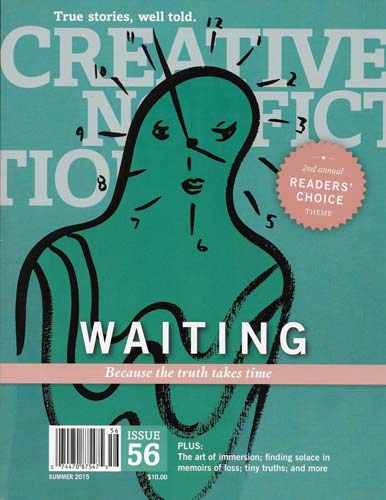Creative Nonfiction – Summer 2015
Pinning down a comprehensive definition of the term creative nonfiction appears to be an imprecise, ongoing pursuit. Creative Nonfiction’s section editor Dinty W. Moore tackles the subject with “A Genre by Any Other Name?” Noting that Creative Nonfiction Editor Lee Gutkind did not invent the term, Moore brings in quotes from essayist Phillip Lopate and author Philip Gerard who pooh-pooh the term, then he picks up more positive opinions of the classification, calling on various other writers, editors, and critics. Pinning down a comprehensive definition of the term creative nonfiction appears to be an imprecise, ongoing pursuit. Creative Nonfiction’s section editor Dinty W. Moore tackles the subject with “A Genre by Any Other Name?” Noting that Creative Nonfiction Editor Lee Gutkind did not invent the term, Moore brings in quotes from essayist Phillip Lopate and author Philip Gerard who pooh-pooh the term, then he picks up more positive opinions of the classification, calling on various other writers, editors, and critics.
The theme of the Summer edition is “Waiting: Because the Truth Takes Time.” Fitting this theme precisely, Maggie Messitt in “Waiting and Wading through Story” describes her wait in a South African village to fill her book The Rainy Season with narratives and exposition about the lives of three residents. “In September 2005, I started my first month of intense immersion inside Rooibok, a community of three hundred Shangaan, Sotho, and Mozambican Tsonga families,” she writes. “[ . . . ] years later, what I’ve realized is this: immersion is about waiting. It’s not about finding a story to fit inside your pre-constructed ideas, but letting the story unfold.”
The Essay section begins with “Any Given Day” by Judith Kitchen, a popular and prolific writer who died in 2014. She encapsulates each month from May to September into a weekday. Her favorite World Cup players and her chemotherapy combine with an exploration of where home really is. On a Tuesday in early June, she’s in chemo, tracing Tuesdays “back through time” when her sons were preschoolers and she waited to be needed. “And nearly fifty years later, I still wait, a Tuesday in June, for my life to catch up with me.” Kitchen’s Friday in September:
Until now, my waiting has always seemed anticipatory. But this is different. [ . . . ] If this were soccer, the doctors would be offside. The ball called back: free kick. But what is the goal, now that we know we don’t know? There are no rules. What claims our attention? The ball, with its spherical secrets? The cell, with its secret spheres?
Retired attorney Josephine Fitzpatrick’s “Lost and Found” guides us through her 42-year wait to receive confirmation that her stepbrother was killed in action during the Vietnam War. Sue William Silverman recounts waiting rooms she’s known—hospitals, airports, Toyota service departments, funeral homes—in “Until My Number Is Up,” while “Sleepless in Any City” by Janine Zeitlin dwells on being awakened each night by a thump, thump. “I am living ‘The Tell-Tale Heart.’ Am I crazy? Relax, I think, which causes me not to.”
Nathan Elliott begins his essay with item number 12 on an application for permanent Canadian residency in “Pushing the Boundaries: An Honest Application.” He composes a polite, succinct answer to the question requesting details about his relationship with his wife, needed as proof that the relationship is “genuine and continuing.” He enhances this with footnotes several pages long. It brought to mind Jenny Boully’s book The Body: An Essay, written entirely in footnotes. Elliott’s clever notes reveal the nitty-gritty of his relationship, which is fun and lively entertainment.
Joe Fassler continues this issue’s theme with “Wait Times.” His wife Rachel wakes in pain. At the hospital she is misdiagnosed and ignored. Fassler accents his story with italics added to responses, or lack of responses, by medical personnel during the 14 ½ hours until Rachel is correctly diagnosed and operated on. At one point he writes, “The overworked nurses heard me begging, their faces, unmoved, like objects carved from wood. Rachel’s suffering was invisible to them.” And of waiting:
Average time, in 2013, a Brooklyn Hospital Center patient spent in the emergency room before being seen by a doctor: one hour, forty-nine minutes. National average during the same time period: twenty-eight minutes.
As engrossing as the selections in this issue are, the subjects of death, near death and grief were common, which made me need an occasional time-out from reading. But the quality of writing and the promise of upcoming themes like The Weather and Childhood encourages me to check into future issues of Creative Nonfiction to share in the new perspectives writers create on those subjects.
[www.creativenonfiction.org]





